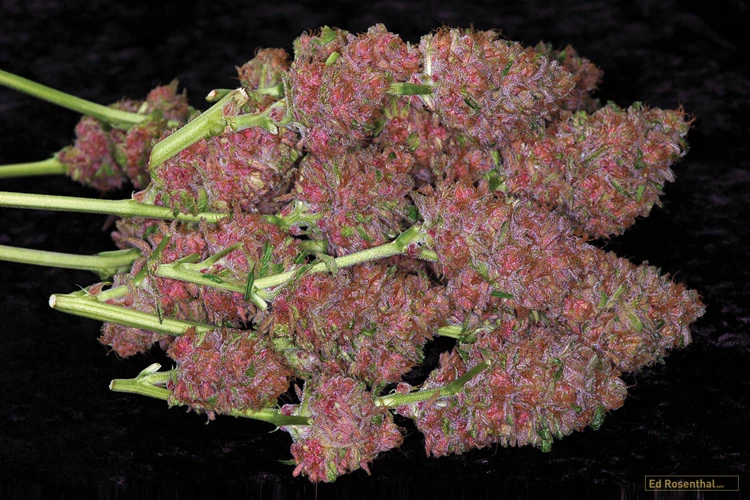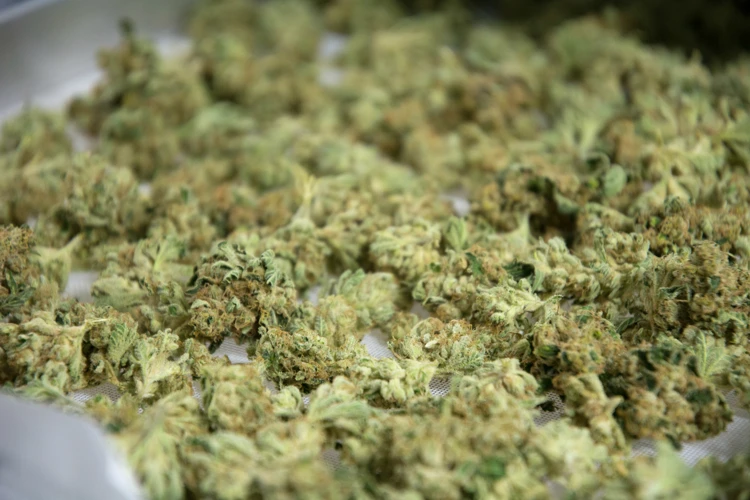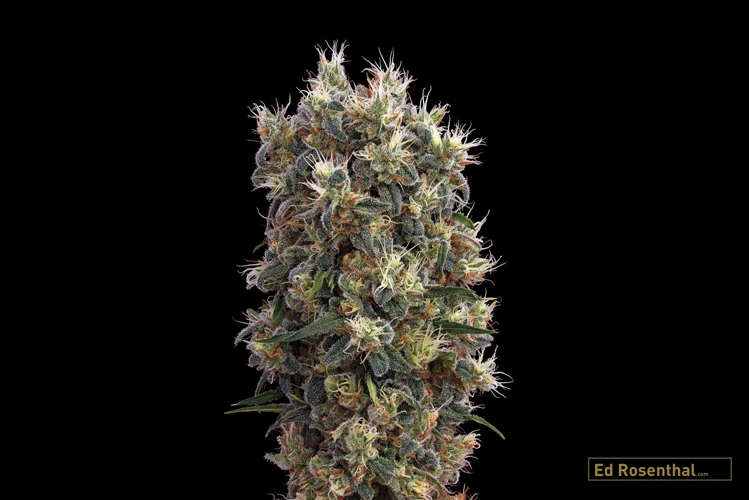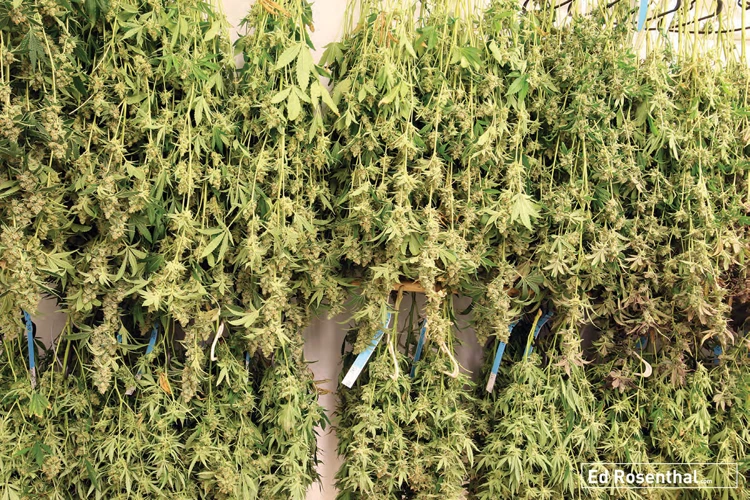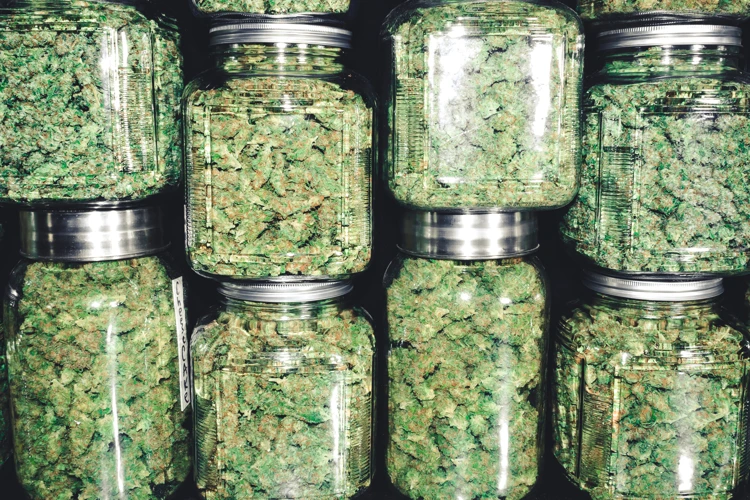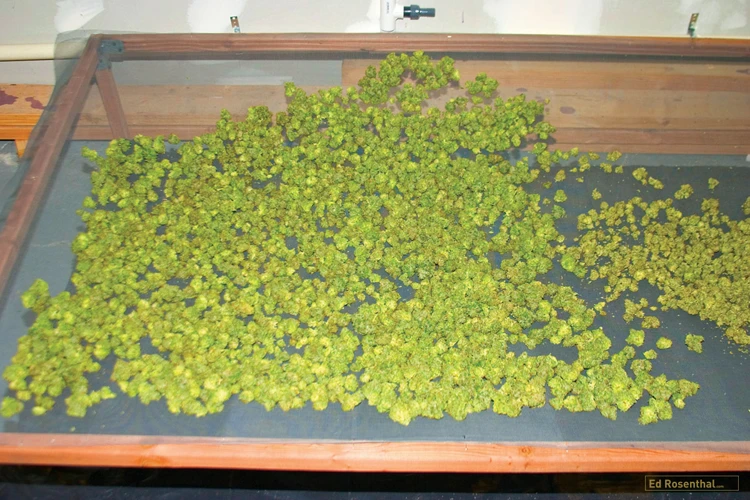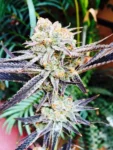
The Role of Curing in Enhancing Aroma, Taste, and Effects of Cannabis Flowers
Growing cannabis is only half the battle when it comes to creating a high-quality product. The other half lies in the curing process, which is often overlooked or rushed. It’s a process that can make or break the entire cannabis experience, from the aroma and flavor to the overall potency. But what exactly is curing, and why is it so important? In this article, we’ll delve into the world of cannabis and explore the intricacies of the curing process, including how it works, its importance, and how to properly cure your own cannabis for optimal results.
What is Curing?
Contents
When it comes to consuming cannabis, the experience isn’t just about the strain or potency. The curing process plays a critical role in the final product’s aroma, flavor, and effects. But what exactly is curing? Simply put, it’s the process of drying the harvested plant matter in a controlled environment to achieve optimal results. However, the practice of curing isn’t as straightforward as it may seem. Understanding the purpose and science behind it is key to unlocking the full potential of your cannabis harvest. Let’s delve into the intricacies of this crucial cannabis care step.
The Purpose of Curing
When it comes to the process of cannabis cultivation, curing is one of the most critical steps for achieving high-quality and potent buds. The purpose of curing is to break down complex sugars and other compounds within the plant material, which results in a smoother smoke and more potent effects from the cannabinoids and terpenes present in the buds. Without properly curing cannabis, the buds may have harsh, unpleasant flavors and can be less potent.
Curing is important to get rid of excess moisture from the harvested buds. The drying process alone is not enough to get rid of all the moisture in the buds, and if the buds are not cured properly, they may develop harmful mold or mildew, which can ruin the entire crop. Additionally, curing allows buds to be stored for longer periods, without losing their potency or flavor.
The purpose of curing is to enhance the aroma, taste, and potency of cannabis buds, making for a more enjoyable and potent experience for users. Properly cured cannabis can result in a smoother, more flavorful smoking experience, making it much more enjoyable for users. On the other hand, cannabis that has not been cured properly can be harsh, produce an unpleasant taste, and may lack potency.
How Does Curing Work?
Curing is the process of drying and aging cannabis after it has been harvested. This process is essential for achieving the best possible aroma, taste, and effects from the plant. Curing involves a precise balance of humidity, temperature, and air circulation, creating an optimal environment for the buds to mature and develop their signature characteristics.
During the initial drying phase, moisture from the innermost parts of the bud slowly moves to the surface, where it evaporates. This process of moisture movement is called transpiration. Once the outer layers of the bud are dry, curing begins. The remaining moisture inside the plant is drawn out slowly over time, allowing the buds to mature and develop their rich, complex flavors and aromas.
Curing also allows the plant’s chlorophyll and other pigments to break down, resulting in a smoother smoke and a more enjoyable experience. It helps to break down any residual chlorine, pesticides, and fertilizers that may be present, making the cannabis safe to consume.
The length of the curing process depends on various factors, such as the moisture content of the buds, the temperature and humidity of the curing environment, and the desired characteristics of the final product. Generally, a curing period of 2-4 weeks is recommended for optimal results.
Curing is a crucial part of the cannabis cultivation process that should not be overlooked. Proper curing can elevate the quality of the final product, resulting in a more enjoyable experience for the user.
Why is Curing Important?
As a cannabis enthusiast, you may have wondered why curing plays such an essential role in the cultivation process. Cannabis curing is a crucial process that helps unlock the full potential of the plant. Without proper curing, the cannabis buds may lack in aroma, flavor, and potency. Through a controlled process of drying and storing cannabis, the curing process enhances the quality of the cannabis buds while also preserving its freshness for long-term use. In this section, we will explore the reasons why curing is so important for any cannabis cultivator who seeks to achieve top-quality buds.
Improved Aroma and Flavor
One of the key benefits of properly curing cannabis is improved aroma and flavor. Curing allows for the preservation and development of terpenes, the organic compounds responsible for the distinctive scents and tastes of individual strains.
During the curing process, terpenes begin to break down and release their aromas, resulting in a stronger and more complex flavor profile. The longer the curing process, the more pronounced and developed the flavors become.
Curing can also remove unwanted smells and tastes caused by the presence of chlorophyll and other compounds. Without proper curing, cannabis can have a harsh, bitter taste and an unpleasant odor.
Some of the most popular cannabis strains are known for their unique terpene profiles, which give them their distinctive aromas and flavors. Curing is essential for preserving these characteristics and enabling them to fully develop.
Properly cured cannabis can offer a more enjoyable smoking experience overall. The full range of flavors and aromas can enhance the experience and make smoking a more satisfying and nuanced experience for consumers.
| Benefits of Proper Curing: |
|---|
| Preserves and develops terpenes |
| Results in stronger and more complex flavors |
| Removes unwanted tastes and odors |
| Preserves unique terpene profiles of different strains |
| Enhances overall smoking experience |
Enhanced Potency
One of the most important benefits of curing cannabis is that it can lead to enhanced potency. This is due to the fact that curing reduces the amount of moisture in the buds, which can increase the concentration of cannabinoids like THC and CBD. Additionally, curing can also cause the degradation of other compounds like chlorophyll, which can have a negative effect on potency and flavor.
To fully understand the impact of curing on potency, it’s important to recognize the role that moisture content plays in the potency of cannabis. Buds that have high levels of moisture tend to be less potent, as the water molecules can interfere with the ability of cannabinoids to bind with receptors in the body. This is why it’s important to properly dry and cure cannabis in order to achieve the desired level of potency.
In addition to reducing moisture content, curing can also enhance potency by allowing certain chemical processes to take place. During the curing process, the buds are exposed to air and can undergo oxidation, which can lead to changes in the chemical composition of the plant. As a result, certain cannabinoids may become more potent or more bioavailable, leading to a stronger therapeutic effect for the user.
It’s important to remember that not all strains of cannabis will respond the same way to curing. Factors like genetics, cultivation practices, and environmental conditions can all impact the potency and overall quality of the final product. However, for most strains of cannabis, proper drying and curing is essential for achieving the desired level of potency and maximizing the therapeutic benefits of the plant.
How to Cure Cannabis
Curing cannabis is a fundamental process that requires skill and attention to detail. Whether you are an experienced cultivator or a beginner, curing can be a perplexing process. However, by following a few simple steps, you can quickly become an expert in curing cannabis. In this section, we will explain the essential practices for curing cannabis, including harvesting, drying, and curing. By the end of this section, you will feel confident in your ability to cure cannabis and produce a high-quality flower with excellent aroma, taste, and potency.
Harvesting Cannabis
When it comes to harvesting cannabis, there are some things that you should keep in mind to ensure a quality product. Here are some steps to follow for harvesting cannabis:
- Timing is crucial. Harvesting cannabis at the right time is crucial for a successful curing process. You need to make sure that the trichomes have reached their peak potency. This is when they are milky / cloudy and have started to turn amber. If you harvest the cannabis too early, you run the risk of losing potency.
- Use clean tools. When it’s time to harvest, make sure you use clean tools to avoid contamination. Use gloves and sterilize tools with rubbing alcohol before you start.
- Harvest in stages. Harvesting all of your cannabis at once can be overwhelming. Instead, consider harvesting in stages to make sure you don’t lose any buds along the way. This will also help you to stagger your curing process so that you don’t have to deal with all of your cannabis at once.
- Cut the branches. When you’re ready to harvest, use a pair of pruning shears to cut the branches off the plant. Make sure you leave enough stem attached to the bud so that you can hang them to dry.
- Hang the buds to dry. After you’ve cut the branches, hang them in a dark, cool room with good air circulation. You can either hang the branches as they are or remove the individual buds from the branches and hang them individually. Just make sure that they’re not touching each other.
- Be patient. Drying cannabis can take anywhere from 5-14 days depending on the humidity and temperature of your drying room. You’ll know your cannabis is dry when the stems start to snap instead of bending.
Remember, harvesting is just the first step in the curing process. Proper drying and curing are essential for a quality end result.
Drying Cannabis
Before curing, it is essential to properly dry the cannabis. Drying cannabis involves removing most of the moisture from the buds while still preserving the trichomes and terpenes that give cannabis its unique aroma and flavor.
Here are the steps you should follow to properly dry your cannabis:
- Trim the buds: Trim any excess leaves from the buds, leaving only the flower. This will make the drying process more efficient.
- Hang the buds: Hang the buds upside down in a cool, dry, and dark place. This can be accomplished by using a hanger, clothesline, or mesh rack. Make sure the buds are not too crowded, and there is good air circulation around them.
- Maintain the humidity: To prevent mold growth, keep the humidity between 45-55%. You can use a hygrometer to monitor the humidity levels in the drying area. If the humidity levels are too high, consider adding a dehumidifier. If the humidity levels are too low, try using a humidifier.
- Check on the buds: Check on the buds daily, to ensure they are drying properly. Buds should feel dry on the outside, but still slightly spongy when squeezed.
- Cure the buds: Once the buds are dry, they are ready for the curing process.
Properly drying your cannabis is crucial to achieving high-quality buds with enhanced aroma, flavor, and potency. Don’t rush the drying process, as this can result in harsh-tasting buds that lack the desired effects.
Curing Cannabis
Curing cannabis is a crucial process in enhancing the aroma, taste, and effects of the plant. It involves drying and aging the buds in a controlled environment to achieve optimal results. The following steps are involved in curing cannabis:
| Step 1: Trim the Buds | Before curing, it is important to trim the buds to remove excess leaves and stems. This will improve the appearance and quality of the buds. Use a pair of scissors or a sharp knife to carefully remove the unwanted parts. |
| Step 2: Mason Jars and Moisture Packs | After trimming the buds, place them in mason jars with moisture packs. These packs will control the humidity inside the jars and prevent the buds from becoming too dry or too moist during the curing process. |
| Step 3: Burp the Jars | It is important to “burp” the jars daily to release any excess moisture and gases that are produced during the curing process. This will prevent molding and ensure that the buds dry and cure evenly. |
| Step 4: Store in a Cool, Dark Place | Cured cannabis should be stored in a cool, dark place to preserve its potency and quality. Avoid exposing the buds to direct sunlight or high temperatures, as this can degrade the quality of the plant. |
By following these steps, you can ensure that your cannabis is properly cured and ready for use. Properly cured cannabis will have a better aroma, taste, and effects than uncured cannabis. It is an essential step in the cultivation process that should not be overlooked.
Factors that Affect Curing
When it comes to curing cannabis, there are numerous factors that can affect the overall outcome. From humidity and temperature to air circulation and light exposure, each element plays a vital role in the final product. It’s important to take these factors into consideration and create an environment that promotes optimal curing conditions. Let’s dive deeper into some of the key factors that have a significant impact on cannabis curing.
Humidity and Temperature
Maintaining the right levels of humidity and temperature is crucial for a successful curing process. The ideal humidity range for curing cannabis is between 55-65%. Humidity levels higher than this can cause mold growth and compromise the quality of the buds, while levels lower than this can cause the buds to become too dry and harsh.
Similarly, the temperature for curing cannabis should be kept between 60-70°F. Higher temperatures can cause the buds to dry out too quickly, leading to a brittle and harsh end product. Lower temperatures can slow down the curing process and create an environment where mold and other harmful bacteria can grow.
To help maintain the right levels of humidity and temperature, it is recommended to use a hygrometer and a thermometer in the curing area. These tools can provide accurate readings and help you adjust the environment as needed.
It is important to note that during the first few days of curing, the humidity levels may be higher than the ideal range as the moisture inside the buds equalizes. This is normal and as long as the humidity levels are brought back down within a few days, it should not cause any issues.
Maintaining the right humidity and temperature levels is just one factor in a successful curing process. Proper air circulation and light exposure can also play a crucial role in achieving high-quality, well-cured cannabis buds.
Air Circulation
One important factor that affects the curing process of cannabis is air circulation. Proper air circulation allows for a more even distribution of air, which helps to prevent the growth of mold and bacteria. Without proper air circulation, pockets of stagnant air can form, which can lead to moisture buildup and increased risk of mold. Here are some key points to consider for optimal air circulation during the curing process:
- Proper Ventilation: It is important to ensure that the curing area has adequate air flow. This can be accomplished by utilizing fans or opening windows to promote air exchange.
- Distance: Be sure to leave enough space between buds during the curing process to allow for proper air flow. Crowding buds together can reduce air flow, resulting in uneven drying and increased risk of mold.
- Positioning: When positioning fans, try to direct air towards the top of the curing area and towards the buds as opposed to directly onto them. This can help to prevent the buds from becoming too dry too quickly.
- Timing: Air circulation should be consistent throughout the entire curing process. The first few days of curing are especially critical, as this is when excess moisture needs to be wicked away. After the first few days, continue to monitor air circulation to ensure it remains consistent.
By paying close attention to air circulation during the curing process, you can help ensure that your cannabis retains its optimal quality and potency.
Light Exposure
Light Exposure
Many cannabis growers and enthusiasts are aware of the importance of humidity and temperature in the curing process, but the necessary consideration for light exposure is often overlooked. Light exposure can have a significant impact on the potency and flavor of cured cannabis.
- UV Light: Exposure to UV light can break down certain compounds in cannabis, such as THC, and reduce potency. It is therefore important to protect cannabis from UV light during the curing process.
- Visible Light: Exposure to visible light, even for short periods, can cause deterioration of terpenes, compounds that give cannabis its distinctive aroma and flavor.
To prevent degradation from light exposure, it is recommended to store cured cannabis in a dark place or using opaque containers. If storing in clear or translucent containers, it is essential to keep them in a dark environment.
It is important to note that improper light exposure can have a cumulative effect over time, so it is crucial to prevent light exposure in all stages of cannabis development, including during growth and drying.
| Problems | Effects | Solutions |
|---|---|---|
| UV Light Exposure | Breaks down THC and reduces potency | Protect from UV light during curing and store in a dark place |
| Visible Light Exposure | Causes deterioration of terpenes, reducing aroma and flavor | Store in a dark place, use opaque containers or keep clear/translucent containers in a dark environment |
| Improper Light Exposure | Cumulative effect over time, leading to reduced potency and flavor | Prevent light exposure in all stages of cannabis development |
By taking care to minimize light exposure during the curing process, cannabis enthusiasts can ensure the full potential of their harvest’s potency and flavor.
How Long to Cure Cannabis
Determining the duration of cannabis curing time depends on various factors, such as the type and strain of cannabis, the growing conditions, and the desired level of potency and aroma. In general, cannabis should be cured for at least two weeks to achieve a better flavor, and potentially longer for increased potency.
During the curing process, trichomes continue to mature, which increases the potency of the buds. When buds are first harvested, they typically have a potency level of around 50% of their full potential. By allowing them to cure, the potency level can increase to around 70-90% of full potential.
Cannabis growers typically check on the buds regularly during the curing process to ensure they are not under or over-cured. Over-curing can reduce potency, and in some cases, cause mold growth, while under-curing can result in harsh smoke and reduced aroma.
The optimal duration of curing should be determined by sensory testing of the buds. The buds should be examined for color, texture, and aroma, with the aroma being the most important factor. When the buds are hung to dry, they will have a strong and somewhat harsh odor. As the buds begin to cure, the aroma will become more muted and pleasant.
Once the buds have been in storage for a week or two, the grower should evaluate their progress. If the aroma is still harsh, the buds may need additional time to cure. If the aroma is muted but pleasant, the buds have likely reached their optimal level of curing.
In general, the curing process can last from two weeks up to several months depending on the grower’s preference. Keep in mind that the longer the buds cure, the more potent and flavorful they will become. However, it is important not to over-cure the buds, as they can lose potency over time.
Storing Cured Cannabis
Now that you have successfully cured your cannabis, the next step is to properly store it to maintain its potency, aroma, and flavor. An important aspect of storing cured cannabis is ensuring that it is protected from light, humidity, and oxygen exposure. Let’s take a closer look at some key factors to consider when storing your cured cannabis to help it reach its full potential.
Container Options
When it comes to storing cured cannabis, the container you choose can make all the difference. Light, air, and moisture are the three main factors that can degrade cannabis potency and quality over time. The ideal container should be airtight, odor-proof, and light-proof to keep your cannabis fresh for as long as possible. Here are some container options to consider:
| Container Type | Pros | Cons |
|---|---|---|
| Glass Jars with Rubber Seals | – Airtight and can be reused – Non-reactive material won’t affect taste or smell – Allows for easy monitoring and inspection |
– Can break if handled improperly – Can allow light to penetrate if not opaque |
| Metal Tins | – Airtight and durable – Can be a good option for travel – Opaque to prevent light penetration |
– Can affect taste and smell over time due to metal composition – May not be ideal for long-term storage |
| Vacuum-Sealed Bags | – Completely airtight to prevent oxidation – Can be a good option for storing large quantities – Can be convenient for travel |
– Not ideal for long-term storage – Not as visually appealing as other options – May flatten or crush buds over time |
| Plastic Containers with Rubber Seals | – Airtight and can be reused – Inexpensive and readily available – Variety of sizes available |
– Can affect taste and smell over time due to plastic composition – Can allow light to penetrate if not opaque |
No matter which container you choose, it’s important to store your cannabis in a cool, dark place with stable temperature and humidity levels. Avoid storing your cannabis in the refrigerator or freezer, as this can introduce excess moisture and cause the trichomes (the tiny hairs on the buds that contain THC and other cannabinoids) to become brittle and break off.
Storage Conditions
Proper storage conditions are important for maintaining the quality of cured cannabis. Once the ideal moisture content has been achieved, it is important to store the cannabis in a cool, dry, and dark place.
Temperature: Ideally, the temperature for storing cannabis should be between 60-70°F (15.5-21°C). Temperatures that are too high can cause the cannabinoids in the cannabis to degrade, leading to a loss of potency. On the other hand, temperatures that are too low can cause the trichomes to become brittle and break off, leading to a loss of flavor and potency over time.
Humidity: The humidity for storing cannabis should be between 59-63% relative humidity. If the humidity level is too high, it can create an environment where mold or other harmful bacteria can grow. If the humidity level is too low, the cannabis can become too dry and lose its potency and flavor.
Light exposure: Light can also have a negative impact on the quality of stored cannabis. Exposure to light can break down cannabinoids and cause the cannabis to become less potent. It is best to store cannabis in a dark location, such as a pantry or closet.
To ensure the best possible storage conditions, it is recommended to use an airtight container made of glass, metal, or ceramic. This will help to maintain proper temperature and humidity levels while also protecting the cannabis from exposure to light. It is important to avoid plastic containers as they can give off a static charge that can pull trichomes from the cannabis. Additionally, some plastic containers contain chemicals that can leach into the cannabis over time.
Proper storage conditions are crucial for maintaining the quality of cured cannabis. By keeping the cannabis in the right temperature, humidity, and light conditions, it is possible to preserve its potency, aroma, and flavor for many months to come.
Effects of Improper Curing
Not curing cannabis properly can have a significant impact on the quality of the final product. Improperly cured cannabis can be harsh and unpleasant to smoke, lacking in aroma and flavor, and less potent. The curing process is crucial in allowing the plant to properly break down and convert chlorophyll into sugars and starches, which enhances the aroma, taste, and effects of the cannabis.
One of the primary issues with improperly cured cannabis is that it can be harsh and unpleasant to smoke or vaporize. This is because drying too quickly or failing to properly cure can result in a harsh, throat-burning smoke that can cause coughing or even lead to headaches. This is because the chlorophyll in the plant material hasn’t been adequately broken down, and the essential oils haven’t been allowed to develop and fully mature.
In addition to being harsh on the throat, improperly cured cannabis may also lack aroma and flavor. This is because the essential oils responsible for the plant’s unique aroma and flavor haven’t been allowed to properly develop. Without proper curing, the terpenes and other compounds that give cannabis its distinctive aroma and flavor will be lost, leaving a bland and uninspiring product.
Finally, improperly cured cannabis may also be less potent than properly cured cannabis. As the plant dries and cures, the cannabinoids in the plant material continue to convert from their acidic forms into their active forms. If this process is rushed or the conditions are improper, then the cannabinoids may not fully convert, leading to a less potent product.
Failing to properly cure cannabis can have significant consequences for the quality of the final product. Not only will it be harsh and unpleasant to smoke, but it may lack the aroma, flavor, and potency that make cannabis such a sought-after commodity. It’s crucial to take the time to properly cure your cannabis to ensure that it delivers the best possible experience.
Curing vs. Aging
Curing and aging are often confused when it comes to storing cannabis. However, they are two different processes with distinct purposes. Curing is the process of preserving the quality of cannabis by allowing it to mature and develop its unique aromas and flavors over time. On the other hand, aging refers to the process of storing aged cannabis to preserve its potency and effects.
Curing can last anywhere from a few weeks to several months, depending on a variety of factors such as humidity, temperature, and air circulation. During the curing process, the buds are placed in airtight containers and stored in a cool, dark place, allowing the plant’s natural terpenes to mature and develop. Proper curing helps to break down chlorophyll and other compounds in the plant, resulting in a smoother smoke and more pleasant taste and aroma.
Aging is more commonly used to refer to the process of preserving marijuana’s potency for an extended period. Unlike curing, which generally takes place within a few months of harvesting the buds, aging is a long-term process that can continue for several years. During the aging process, the cannabis is stored in a dark, cool place, with a humidity-controlled environment that prevents the buds from drying out.
When cannabis is aged properly, the THC content can increase, making it more potent and providing a stronger high. However, aging can also negatively impact the flavor and aroma of the buds, making them less enjoyable to smoke. Additionally, the longer cannabis is aged, the more it can degrade, leading to a less satisfying overall experience.
While curing and aging both involve storing cannabis for an extended period, they serve different purposes. Curing is used to enhance the aroma and flavor of the buds, while aging is focused on preserving their potency. Both processes require careful attention to humidity, temperature, and other environmental factors to ensure that the cannabis remains in the best possible condition.
Conclusion
In conclusion, curing cannabis properly is an essential part of the cultivation process. It not only enhances the aroma and flavor of the final product, but it also increases its potency and effects. Through proper drying, curing, and storage, the full potential of the plant is unlocked.
It is important to consider the various factors that may affect the curing process, such as humidity and temperature, air circulation, and light exposure. These factors should be monitored and adjusted accordingly to ensure the best results.
Improper curing can have negative effects on the final product, including a harsh taste and decreased potency. It is crucial to follow the proper steps and timing to avoid these negative outcomes.
It is also important to note the difference between curing and aging. While curing is the process of controlling the humidity and temperature to enhance the flavor and potency, aging is the process of allowing the already-cured cannabis to sit and further develop flavor and potency over a longer period of time.
Overall, curing cannabis is a crucial step in the cultivation process that should not be overlooked. By taking the time and effort to properly cure and store cannabis, the final product will be enhanced in aroma, flavor, and effects, ultimately resulting in an improved experience for the consumer.
Frequently Asked Questions
What happens if you don’t cure cannabis?
If cannabis is not cured properly, it can lead to a harsh taste, uneven burn, and reduced potency.
Can you cure cannabis too long?
Yes, overcuring can lead to dry, brittle buds that crumble and lose potency.
What is the ideal temperature and humidity for curing cannabis?
The ideal temperature for curing cannabis is between 60-70°F with a relative humidity of 60-65%.
How long should you dry cannabis before curing it?
Cannabis should be dried for 3-7 days until the stems snap when bent before being cured.
What is the difference between drying and curing cannabis?
Drying cannabis removes moisture, while curing cannabis allows it to develop a richer aroma, flavor, and potency over time.
Is it necessary to cure cannabis if I’m going to make edibles?
No, curing is not necessary if using cannabis for edibles as the heat of the cooking process will decarboxylate the THC.
Can I cure cannabis in a plastic container?
Yes, but it’s important to use containers with airtight seals and to burp them regularly to prevent mold growth.
What is the best way to store cured cannabis long-term?
The best way to store cured cannabis long-term is in an airtight container, in a cool, dark place with a relative humidity of 50-60%.
What is the difference between curing and aging cannabis?
Curing is the process of drying and storing cannabis, while aging involves storing cured cannabis for an extended period to allow for further decomposition of chlorophyll and other compounds.
Does curing affect the potency of cannabis?
Yes, curing can enhance the potency of cannabis by allowing cannabinoids to develop and break down further over time.

